November 7
Jerusalem: More of the Old City, West Jerusalem
I woke up again with an annoying assemblance of mosquito bites, including five on the palm of one hand and one on the bottom part of my nose that connects to my upper lip. We had no hot water, so we went down for a breakfast of lukewarm toast, hard boiled eggs and tea, though the marmalade was quite good, as much as I usually dislike the stuff. Our waiter, an Arab Christian, began to rant like a lunatic about how all the Jews and Muslims were to scourge of humanity. If this were any other time of day, I would have enjoyed his foolishness and made the most out of arguing with him, but the tea was weak and I was trying to butter my limp toast, yet he would not go away. We then told him to shut up and get out of our breakfast, so he proceeded to go to the window and talk to himself.
We decided to complain to the management, so we found this one Palestinian man who had lived in Detroit and who had been a lot of fun talking to on previous occasions. Susanne began an excellent speech about how we don't want to be forced into political discussions at breakfast, or we would leave immediately, etc., etc. But the poor man, looking absolutely confused and sorry for us, finally said, "Why are you telling me this? I said I was from Detroit. I'm just visiting." Totally embarrassed, I burst out laughing while Susanne tried to cover her remarks by explaining we were convinced he had to work here, since he was always hanging out with the staff. He said he had been staying at the hotel for over two weeks and had become friendly with the management, which was why he was always around when they were working.  Blushed beyond all recognition, we finally found the real manager and complained to him, who promised that the waiter "would never speak" to us again. Now that the man had been orally banished from our presence, it was time for us to check out the Armenian Quarter of the Old City.
Blushed beyond all recognition, we finally found the real manager and complained to him, who promised that the waiter "would never speak" to us again. Now that the man had been orally banished from our presence, it was time for us to check out the Armenian Quarter of the Old City.
The Armenian Quarter's main street, al-Khattab, extends perpendicularly from the start of David St, near Jaffa Gate. Unfortunately, it was still very early in the morning, and the Quarter was quiet, so we walked through to Zion Gate, the entry point to Mount Zion. A significant portion of Zion has been co-opted by a sephardic synagogue and yeshiva. We entered the yeshiva's plaza and were soon met by a grey-bearded Jewish man who gleefully directed us to each point of interest, upon my donation of about 10 shekel's worth of tzedaka in order to help the Yeshiva's restoration project.
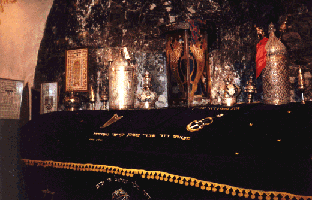
First, we entered King David's tomb, a large wooden coffin in a small room, draped with numerous prayers and poems in Hebrew. Initially, we chose not to take any pictures there, but when the plaza keeper noticed our hesitation, he turned us around, saying, "It's King David - you must bring back pictures to America." Two or three shots later, the man directed us to the room of the last supper, which happened to be on the second floor of the yeshiva. The room itself was almost empty, and thus helped conjure detailed images of the event, from Dali's bright yellow painting to Mel Brooks as Jesus' inept waiter in History of the World, Part 1. Flourishings of Arab inscriptions on the wall suggested that the room had served as part of a mosque at some point in its history.
We wrapped up our trip to Zion a climb to the roof for a view of the city, as well as a quick candle lighting ceremony in the Rebbe's study. 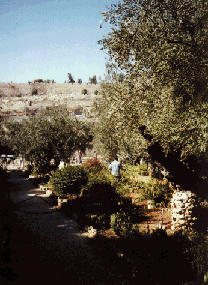 We then started the long walk around the wall of the Old City to get to Gethsemane, which sits on a hill due east of the city. To our disappointment, Let's Go failed to warn us that the outer wall's street was under repair, and we ended up walking through at least a kilometer of sandstone dust and truck exhaust.
We then started the long walk around the wall of the Old City to get to Gethsemane, which sits on a hill due east of the city. To our disappointment, Let's Go failed to warn us that the outer wall's street was under repair, and we ended up walking through at least a kilometer of sandstone dust and truck exhaust.
None the better from the experience, we cut to the right to the church that surrounds the garden of Gethsemane. The site was full of buses and Russian pilgrims, all traveling with groups of Orthodox priests. Scatter among them were hawkers of Pepsi, postcards and rosaries. We squeezed our way into the church and found a small garden with gnarled trees. A Palestinian man watered the grass as I noticed how cigarette butts were as plentiful as the tourists. If I were Christian, I think I would have found the experience to be somewhat undignified. Instead, I just found it amusing.
Leading away from the garden and church we found a sign marked Mary's Grotto, which we took as being the grave of Jesus' mother, Mary. Compared to other sites in Jerusalem, there was little fanfare or spectacle leading up to the entrance of the grotto, which looked like a white church with a long, dark entrance. 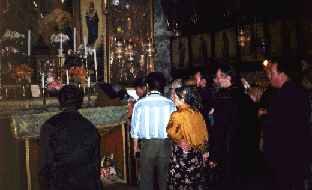 As we proceeded into the crypt, our eyes adjusted to the darkness and we saw a sloping passageway lined with columns of huge Eastern Orthodox candles. Russian pilgrims singing hymns packed the area further down into the crypt, and once we reached the bottom, I could see that the entire floor was filled with about 100 people singing to their hearts' content, holding candles and lining up to enter the small crypt. The whole melange of a dark tomb highlighted by flickering candles and chanting made it seem to me the most appropriately holy Christian site we had visited so far.
As we proceeded into the crypt, our eyes adjusted to the darkness and we saw a sloping passageway lined with columns of huge Eastern Orthodox candles. Russian pilgrims singing hymns packed the area further down into the crypt, and once we reached the bottom, I could see that the entire floor was filled with about 100 people singing to their hearts' content, holding candles and lining up to enter the small crypt. The whole melange of a dark tomb highlighted by flickering candles and chanting made it seem to me the most appropriately holy Christian site we had visited so far.
From Mary's tomb we climbed back up to the Old City, entering at New Gate, and walking down the Via Dolorosa for the third time. We cut left on Khan al-Zeit and weaved through the souk until we found a hidden cafe at the Tabasco Hostel. The turkish coffee there was wonderfully charred, the hummus a bit oily, and the pita quite skimpy, but an Aussie backpacker working at the hostel entertained us as he cursed his way through the sampling over several video tapes until he found Mad Max III - Beyond Thunderdome.
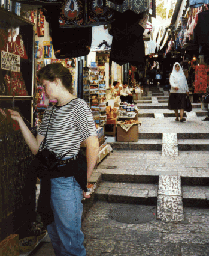 Freshly caffeinated, we spent the next hour or so haunting the souks on Khan al-Zeit and David Streets. Susanne was looking for a present for a friend, while I was just looking for anything that was both interesting and not embarrassing in that "souvenir from Jerusalem" kind of way. I ended up buying a nice relief of the Western Wall, which I added to my collection of things I had purchased so far: a turkish coffee pot, a brass tea pot, an oxidized copper menorah, and a two foot sheesha waterpipe, sans tobacco. Finally, we swung by one of the many spice shops so I could buy an ounce of cheap Mediterranean saffron, only three bucks as compared to well over 100 bucks for its more delicate Spanish cousin.
Freshly caffeinated, we spent the next hour or so haunting the souks on Khan al-Zeit and David Streets. Susanne was looking for a present for a friend, while I was just looking for anything that was both interesting and not embarrassing in that "souvenir from Jerusalem" kind of way. I ended up buying a nice relief of the Western Wall, which I added to my collection of things I had purchased so far: a turkish coffee pot, a brass tea pot, an oxidized copper menorah, and a two foot sheesha waterpipe, sans tobacco. Finally, we swung by one of the many spice shops so I could buy an ounce of cheap Mediterranean saffron, only three bucks as compared to well over 100 bucks for its more delicate Spanish cousin.
We dropped off our purchases at the hotel and headed out for a walk through the ethnic neighborhoods of West Jerusalem. From Kikar Tziona, the city center, we walked north to Mea She'arim, the world's last remaining European-style shtetl. It was quite strange being the only man not dressed up like a 19th century Hasid, but at least we were both dressed modestly enough for no one to take notice of us. The neighborhood is made up mostly of Satmar Hasidim, who actively opposed the existence of the State of Israel, using an interesting argument which claims that Jews have no right to govern the land of Israel until the coming of the Messiah. Therefore, they use the current democratic political structure to convince the rest of the nation that they should dissolve their sovereignty. So far, no such luck.
One of the nice things about Mea She'arim is its abundance of cheap, high quality Judaica shops. We stopped in one shop and I was able to bargain down for a beautiful two-foot shofar, the ram's horn blown on Jewish high holidays, for only $50, about a fourth of the price of what you might pay for a kosher shofar in the States. Granted, I have to admit that this was my most spontaneous and irrational purchase of the trip, but I figured that I'm not in Jerusalem's only shtetl very often, and it would be nice to pick up a future heirloom for my yet-to-exist progeny.
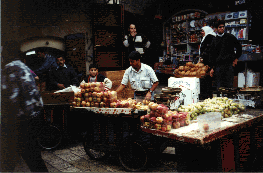 The weather began to turn cold and ugly as we embarked for Mahaneh Yehuda market and the sephardic neighborhoods that lie due south of it. Mahaneh was packed with locals shoppers searching for everything from fresh bread and dates to used fax machines. Having spent the preceding week in the souks of Cairo and the Old City, Mahaneh Yehuda was somewhat of a cultural disappointment, seeming more like an American flea market than an Israeli shuk.
The weather began to turn cold and ugly as we embarked for Mahaneh Yehuda market and the sephardic neighborhoods that lie due south of it. Mahaneh was packed with locals shoppers searching for everything from fresh bread and dates to used fax machines. Having spent the preceding week in the souks of Cairo and the Old City, Mahaneh Yehuda was somewhat of a cultural disappointment, seeming more like an American flea market than an Israeli shuk.
As for the two sephardic neighborhoods of Zikhronot and Nahla'ot, they were almost deserted due to the impending storm. Both communities are home for Jews from Iran, Yemen, Turkey, and other west Asian nations, and I had hoped to catch a glimpse of their world in Jerusalem. But thanks to mother nature, it would have to wait until another trip.
Susanne and I killed about an hour in a local coffee joint as the rain came down. We tried to plot out our plans for the rest of the trip, but we were both plagued by a cough and an itchy throat- a poor omen for our health situation to come. By 4:30, we decided to grab an early dinner, since our 3am departure time for our Masada trip the next day would definitely demand an early bedtime. We ate at the Yemenite Step, a Yemeni Jewish restaurant that specializes in melawach, a fried dough topped with everything from honey to a baked half chicken. Our dinner of chicken melawach and a pilaf of rice, meat and almonds was delicious, though the melawach itself was uncannily similar in taste, texture and appearance to the Pueblo fry bread I had feasted on in New Mexico early that year.
Then it was off to bed at 9pm. I don't remember the last time I crashed that early, but I hoped it would be worth it, with the long day by the Dead Sea that was ahead of us.
 Blushed beyond all recognition, we finally found the real manager and complained to him, who promised that the waiter "would never speak" to us again. Now that the man had been orally banished from our presence, it was time for us to check out the Armenian Quarter of the Old City.
Blushed beyond all recognition, we finally found the real manager and complained to him, who promised that the waiter "would never speak" to us again. Now that the man had been orally banished from our presence, it was time for us to check out the Armenian Quarter of the Old City.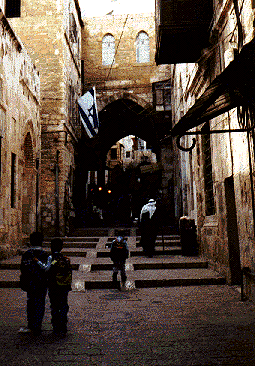 November 7
November 7
 We then started the long walk around the wall of the Old City to get to Gethsemane, which sits on a hill due east of the city. To our disappointment, Let's Go failed to warn us that the outer wall's street was under repair, and we ended up walking through at least a kilometer of sandstone dust and truck exhaust.
We then started the long walk around the wall of the Old City to get to Gethsemane, which sits on a hill due east of the city. To our disappointment, Let's Go failed to warn us that the outer wall's street was under repair, and we ended up walking through at least a kilometer of sandstone dust and truck exhaust. As we proceeded into the crypt, our eyes adjusted to the darkness and we saw a sloping passageway lined with columns of huge Eastern Orthodox candles. Russian pilgrims singing hymns packed the area further down into the crypt, and once we reached the bottom, I could see that the entire floor was filled with about 100 people singing to their hearts' content, holding candles and lining up to enter the small crypt. The whole melange of a dark tomb highlighted by flickering candles and chanting made it seem to me the most appropriately holy Christian site we had visited so far.
As we proceeded into the crypt, our eyes adjusted to the darkness and we saw a sloping passageway lined with columns of huge Eastern Orthodox candles. Russian pilgrims singing hymns packed the area further down into the crypt, and once we reached the bottom, I could see that the entire floor was filled with about 100 people singing to their hearts' content, holding candles and lining up to enter the small crypt. The whole melange of a dark tomb highlighted by flickering candles and chanting made it seem to me the most appropriately holy Christian site we had visited so far.  Freshly caffeinated, we spent the next hour or so haunting the souks on Khan al-Zeit and David Streets. Susanne was looking for a present for a friend, while I was just looking for anything that was both interesting and not embarrassing in that "souvenir from Jerusalem" kind of way. I ended up buying a nice relief of the Western Wall, which I added to my collection of things I had purchased so far: a turkish coffee pot, a brass tea pot, an oxidized copper menorah, and a two foot sheesha waterpipe, sans tobacco. Finally, we swung by one of the many spice shops so I could buy an ounce of cheap Mediterranean saffron, only three bucks as compared to well over 100 bucks for its more delicate Spanish cousin.
Freshly caffeinated, we spent the next hour or so haunting the souks on Khan al-Zeit and David Streets. Susanne was looking for a present for a friend, while I was just looking for anything that was both interesting and not embarrassing in that "souvenir from Jerusalem" kind of way. I ended up buying a nice relief of the Western Wall, which I added to my collection of things I had purchased so far: a turkish coffee pot, a brass tea pot, an oxidized copper menorah, and a two foot sheesha waterpipe, sans tobacco. Finally, we swung by one of the many spice shops so I could buy an ounce of cheap Mediterranean saffron, only three bucks as compared to well over 100 bucks for its more delicate Spanish cousin. The weather began to turn cold and ugly as we embarked for Mahaneh Yehuda market and the sephardic neighborhoods that lie due south of it. Mahaneh was packed with locals shoppers searching for everything from fresh bread and dates to used fax machines. Having spent the preceding week in the souks of Cairo and the Old City, Mahaneh Yehuda was somewhat of a cultural disappointment, seeming more like an American flea market than an Israeli shuk.
The weather began to turn cold and ugly as we embarked for Mahaneh Yehuda market and the sephardic neighborhoods that lie due south of it. Mahaneh was packed with locals shoppers searching for everything from fresh bread and dates to used fax machines. Having spent the preceding week in the souks of Cairo and the Old City, Mahaneh Yehuda was somewhat of a cultural disappointment, seeming more like an American flea market than an Israeli shuk. 

